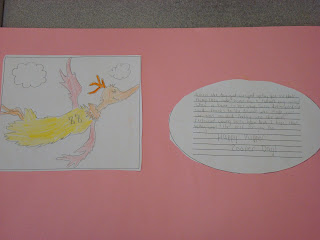

We always begin the unit with simply introducing, "What are connections?"I use the following anchor chart below to introduce this concept.
Before actually making any connections, I am sure to first introduce the word "schema". We always define it as "filing cabinets" in our head. They hold tons and tons of information on all kinds of topics and experiences. We just have to find ways to access it! I always start by first demonstrating with a backpack full of school supplies. The students use their schema to detemine what could possibly be in the backpack. By the end of this demonstration, kids are right on board with the idea!
The next day I introduce our Schema Thinking Stems. We use these as way to show our thinking while we are reading. I modeled how to do this with our very first chapter in Number the Stars. Eventually they did some thinking stems wtih me, before they were finally required to do their own thinking stems throughout the entire novel.
Now I love nonfiction, and I do not feel it gets all the attention it deserves at times. Schema is without a doubt, very important when it comes to understanding nonfiction. I carried this term over in out science block before we were to begin our lesson on how animals were classified. This anchor chart, Activate, Build, and Revise Schema, came from Debbie Miller and her book Reading with Meaning. I use this chart a lot with science and social studies.
As we read through this science lesson, we continued to build our knowledge on this topic and then revise our misconeptions.
From here I went on to the topic of text-to-self connections. My experience with third and fourth graders and connections has been a completely wild experience! I have discovered that children will make connections to anything, even if it has nothing to do with the book at all! I love the book The Relatives Came and find it to be a great starting point for text-to-self connections. I start with a read aloud where I record my own text-to-self connections on sticky notes and add them to our anchor chart. Of course, I do make some quality connections but I also make connections that are completely off key! We work on making connections to the text and pictures.
The whole time my kids are thinking that I know exactly what I am doing! The next day however, I introduce them to the conept of 1 connections and 2 connections.
**1 connections are those that are actually meaningful to the story. They help us to better understand the characters, author, and theme.
An example of a 1 connection from this story that I made was, "I know how it feels to be enjoying yourself so much with family that you don't even think of home".
**2 connections are those that may relate to something in the story, but they do not help us understand what we are reading better.
An example of a 2 connection from the story I made was, "My mom once hit our mailbox in front of our driveway too!"
The kids quickly learned that hitting a mailbox had nothing to do with the meaning behind the story at all. I loved seeing their lightbulbs go off!
I reread the book and students made their 1 connections to the story and we added them to the bottom of the anchor chart.
The next day's lesson was to allow children time to critcially think about making 1 connections. I read the book For the Love of Autumn by Patricia Polacco. I find this book to be incredibly easy for children to relate to in many areas. I read the book aloud while children recorded their own text-to-self connections on sticky notes. Once we were finished I divided them into small groups of 3 or 4. From here they were on their own anaylyze all of their connections and decide which ones were 1 connections and which ones were 2 connections. They then had to divide them up on their own chart paper. At the end all groups were expected to present their chart paper and defend their choices for 1 and 2 connections. This lesson has never failed! Every year students are able to correctly identify their 1 and 2 connections!
Once group presenting their findings!!
From this point forward we continue our work with text-to-self connections through the use of our Connection Journals. This is simply yellow construction paper book with notebook paper and connection organizers stapled inside. We use this journal throughout the entire school year to help us with making quality connections to our stories. Graphic organizers of all kinds can be used. We use venn diagrams to compare books and characters. We have used organizers to make all three types of connections, to relate to specific quotes from the book, and specific settings in a story.























































